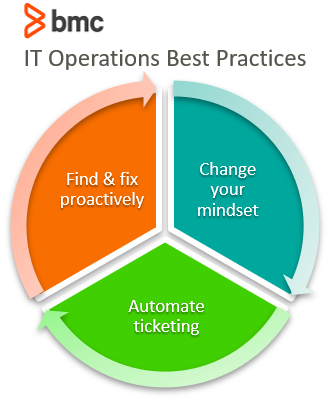The landscape of business is evolving. The demands placed on IT are changing. That means the opportunity for IT operations to embrace a new way of working is upon us.
Traditionally, IT operations are the guardians of the infrastructure, the first responders—but today, IT operations is much more than that. You will no longer find them siloed in the NOC, watching the proverbial Christmas tree as red, orange, and green events pop up on the dashboard. Today’s ITOps specialists will be integrated with build/run product teams where they share ownership and accountability with the dev team, the testers, and the system administrators.
The change that may be the hardest for the seasoned ITOps professional? IT no longer owns production. The production environment is now a collaborative effort with development. It is now time to embrace integrated product teams. They are here to stay—and they are going to change the way you work, if they have not already.
In short, the role of the ITOps team is changing, and the changes are not insignificant. As an ITOps specialist, your ability to new ways of working and embrace this new world will determine your ability to add real value to the organization.

Change your mindset to product teams
One of the most important changes that we are seeing in the world of IT operations is the advent of cross-functional product teams in modern digital organizations. Product teams are replacing project teams. Product teams build the products and then own them in the production environment.
In this model, product teams are comprised of a cross-functional team that contains all the roles that are needed to run the service. Rather than having separate siloed teams of developers, ops, testers, and administrators passing work from one to the other, these roles will work together throughout the life of the service, providing a superior product to business users. This build/run model is becoming the standard way of working in the enterprise.
To survive and prosper in this situation, the ITOps professional will need to change their way of thinking and working. Changing how you think is critical in the success of the product team construct. In a product team, you are no longer an Ops specialist—you are part of an integrated team bringing products to life for the benefit of the business at large.
Automate ticketing and queues
Traditional ticketing and queues are not conducive to success in the product centred world. If these systems aren’t set up optimally, they can create unnecessary barriers to service provision.
Look to automate incident handling and infrastructure provision. This automation will be important to successful rollouts in a product-based way of working.
Collaborate widely
Collaboration is the only way forward in 2021. ITOps can no longer act as the gatekeepers to production systems. The days of forbidding developer access to production systems is gone. I caution: if you are still living the gatekeeper mindset, you need to change now.
The build/run way of working means that you no longer need to have your ops team sitting staring at those screens in the NOC. The key to success? Achieve high availability by partnering across teams—with developers on call, they are highly incentivised to ensure that their systems are stable.
Are ITOps specialists still important?
This doesn’t mean that we no longer need Ops specialists. Yes, you still need monitoring. Yes, events need to be triaged. It’s just that the way they work is changing.
While automation is going to greatly reduce the human factor, it will never completely replace the need for people as a part of this process. It is all a matter of mindset and collaboration between teams. ITOps is a critical player in this world, and they must involve themselves early in the product lifecycle.
I suggest a “think forward” approach: Greater input from Ops in the development process, along with more developer involvement in production, will help the organization achieve better and more reliable results that are delivered faster to customers.
With their holistic view of the IT operating environment the ITOps specialist still has a critical role to play in delivering service excellence to the business. Best practice in IT Operations will enable ITOps teams to:
- Join the application and infrastructure perspective in a single view.
- Easily see which tiers of the applications are impacted and drill down into those tiers to begin the triage process.
- Minimize noise and focus on solving the most impacting business problems first.
ITOps becomes proactive
The ITOps team are no longer firefighters chasing the next event. They are finding and fixing problems before customers have a degraded experience. In a product focused world, ITOps will collaborate with the people who created the services—from the moment an issue is detected—to ensure that errors are identified and removed quickly.
IT Operations is getting smarter, they are trusting the development teams, breaking down silos, and improving business productivity as they go.
Additional resources
For related reading, explore these resources:
- BMC IT Operations Blog
- ITOps, DevOps, and NoOps Explained
- SRE vs ITOps: Are SRE and IT Operations the Same?
- Top IT Operations Trends
These postings are my own and do not necessarily represent BMC's position, strategies, or opinion.
See an error or have a suggestion? Please let us know by emailing blogs@bmc.com.






